The Cook's Illustrated Cookbook (190 page)
Read The Cook's Illustrated Cookbook Online
Authors: The Editors at America's Test Kitchen
Tags: #Cooking

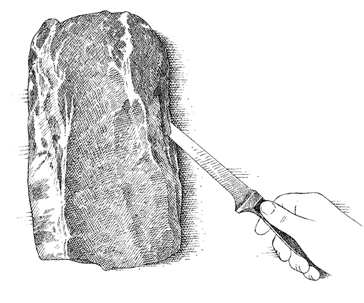
1.
Slice pork open down middle, from end to end, cutting about two-thirds of way through meat. Open pork loin like book.
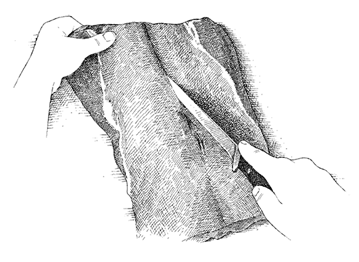
2.
Carefully slice along initial cut, being careful not to cut all the way through, and press pork flat.
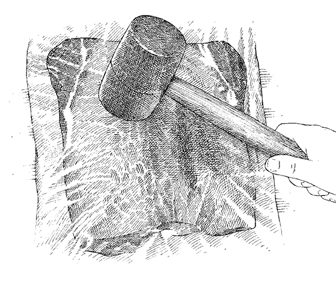
3.
Pound roast to even 1-inch thickness. Then, mound filling evenly down center of roast.
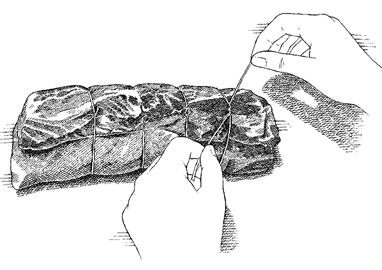
4.
Wrap sides of pork around filling, then tie roast closed with kitchen twine at 1-inch intervals. Don’t tie roast too tight or you may squeeze out filling.
![]() WHY THIS RECIPE WORKS
WHY THIS RECIPE WORKS
It’s easy to fall in love with Tuscan-style pork roast. Flavored with garlic and rosemary and served in thick slices, its juicy meat and crisp crust are part of its allure—that is, when it’s not dry, tough, or bitter. To start, we chose a bone-in, center-cut pork rib roast. Its protective cap of fat and muscle made it the tastiest of all the cuts we sampled, and its rack of bones helped to protect the meat during roasting. Brining the meat in a mixture of water, salt, brown sugar, garlic, and rosemary ensured juiciness and imparted flavor. To add even more flavor, we butterflied the pork loin, then rubbed the meat with a garlic, rosemary, and olive oil paste.
See “BONING A PORK LOIN” illustrations that follow recipe.
See “BUTTERFLYING, SEASONING, AND TYING A PORK LOIN” illustrations that follow recipe.
SERVES 6 TO 8
If the pork is enhanced (injected with a salt solution), do not brine in step 1, and season with salt in step 4. The roasting time is determined in part by the shape of the roast; a long, thin roast will cook faster than a roast with a large circumference. Though not traditionally served, the ribs are rich with flavor. If you’d like to serve them, increase the oven temperature to 375 degrees, untie the roast and remove the loin as directed, then scrape off the excess garlic-rosemary paste from the ribs, set them on a rimmed baking sheet, and return them to the oven for about 20 minutes, until they are brown and crisp. Slice in between bones and serve.
PORK AND BRINE
2¹⁄ | cups packed dark brown sugar |
1 | cup salt |
10 | large garlic cloves, lightly crushed and peeled |
5 | sprigs fresh rosemary |
1 | (4-pound) bone-in center-cut pork rib roast, trimmed |
1 | tablespoon olive oil |
1 | cup dry white wine |
1 | teaspoon pepper |
GARLIC-ROSEMARY PASTE
8 | garlic cloves, minced |
1¹⁄ | tablespoons minced fresh rosemary |
1 | tablespoon extra-virgin olive oil |
1 | teaspoon pepper |
Pinch salt |
JUS
1 | shallot, minced |
1¹⁄ | teaspoons minced fresh rosemary |
1³⁄ | cups low-sodium chicken broth |
2 | tablespoons unsalted butter, cut into 4 pieces and softened |
1. FOR THE PORK AND BRINE:
Using boning knife, carefully cut meat away from rack of bones. Dissolve sugar and salt in 2 quarts cold water in large container. Stir in garlic and rosemary. Submerge pork and bones in brine, cover, and refrigerate for 1¹⁄
2
to 2 hours.
2. FOR THE GARLIC-ROSEMARY PASTE:
While pork brines, mix garlic, rosemary, olive oil, pepper, and salt together in bowl to form paste; set aside.
3.
Remove meat and ribs from brine and thoroughly pat dry with paper towels. Adjust oven rack to middle position and heat oven to 325 degrees. Heat oil in 12-inch skillet over medium heat until just smoking, about 4 minutes. Place roast fat side down in skillet and cook until well browned, about 8 minutes. Transfer roast browned side up to carving board and set aside to cool. Pour off fat from skillet and add wine; increase heat to high and bring to boil, scraping bottom of skillet with wooden spoon to loosen any browned bits. Set skillet off heat.
4.
Make lengthwise incision in pork loin and spread meat flat. Rub with one-third of garlic-rosemary paste, rub remaining paste on cut side of ribs, and tie meat back to ribs. Season browned side of roast with pepper and set roast rib side down in flameproof roasting pan. Pour reserved wine and browned bits from skillet into roasting pan. Roast, basting loin with pan drippings every 20 minutes, until meat registers 140 degrees, 65 to 80 minutes. (If wine evaporates, add about ¹⁄
2
cup water to roasting pan to prevent scorching.) Transfer roast to clean carving board and tent loosely with aluminum foil; let rest about 15 minutes
.
5. FOR THE JUS:
While roast rests, spoon off most of fat from roasting pan and place over 2 burners at high heat. Add shallot and rosemary; scrape bottom of pan with wooden spoon to loosen any browned bits and boil until liquid is reduced by half and shallot has softened, about 2 minutes. Add broth and continue to cook, stirring occasionally, until reduced by half, about 8 minutes. Add any accumulated pork juices and cook 1 minute longer. Off heat, whisk in butter; strain jus into serving bowl.
6.
Snip twine off roast and remove meat from bones. Set meat browned side up on carving board and cut into ¹⁄
4
-inch-thick slices. Serve, passing jus separately.
Reduce wine to ³⁄
4
cup and omit shallot, rosemary, chicken broth, and butter. When pork has roasted 15 minutes, quarter 2 pounds red potatoes; toss with 2 tablespoons olive oil in bowl and season with salt and pepper to taste. After pork has roasted 30 minutes, add potatoes to roasting pan; stir to coat potatoes with pan juices. After transferring roast to carving board, turn potato pieces with wide metal spatula and spread them in even layer. Increase oven temperature to 400 degrees and return potatoes to oven; continue to roast until tender and browned, 5 to 15 minutes longer. Serve potatoes with roast.
Trim 2 fennel bulbs of stalks and fronds; finely chop 2 teaspoons fronds. Halve, core, and cut each bulb lengthwise into eighths. Toss fennel with 1 tablespoon olive oil in medium bowl and season with salt and pepper to taste. Add 1 teaspoon finely chopped fennel seeds and chopped fennel fronds to garlic-rosemary paste. Reduce wine to ³⁄
4
cup and omit shallot, rosemary, chicken broth, and butter. Add fennel to roasting pan along with wine. After transferring roast to carving board, return fennel to oven; continue to roast until tender, 5 to 15 minutes. Serve fennel with roast.
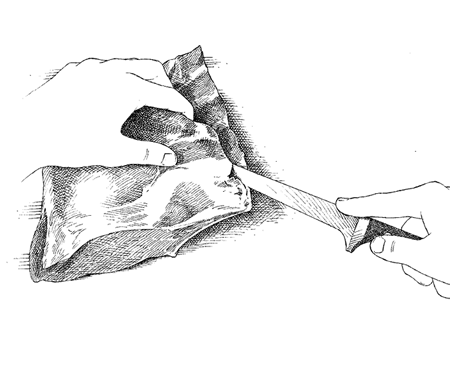
1.
Position roast so bones are perpendicular to cutting board. Starting from far end and working toward you, make series of small, easy strokes with boning knife between meat and bones.
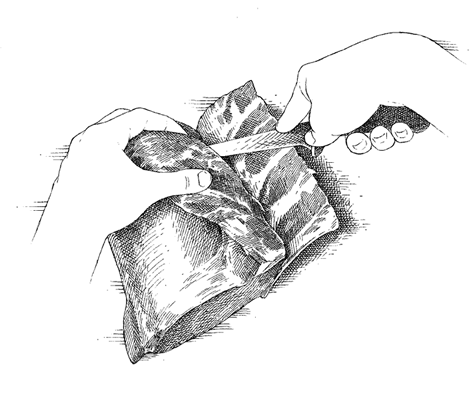
2.
Gradually cut along curved rib bones down to backbone until meat is free from bones.
